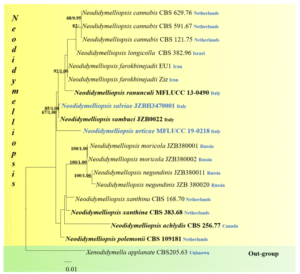Neodidymelliopsis urticae Manawas., Camporesi & K.D. Hyde, sp. nov.
Index Fungorum number: IF 556366; MycoBank number: MB 556366; Facesoffungi number: FoF 06125; Fig. 13
Etymology: Name reflects the host genus.
Holotype: MFLU18-0877.
Saprobic or necrotrophic on dead and dying twigs and branches of Urtica dioica (L.). Sexual morph: Undetermined. Asexual morph: Coelomycetous. Conidiomata on host 78–286 µm diam (x̅ = 157 µm, n = 15), pycnidial, solitary, scattered, globose, black, semi-immersed to immersed; Conidiophores not observed. Conidiogenous cells not observed in host. Conidiogenous cells in culture hyaline, flask-shaped, ampulliform. Conidia on host 4–9 × 1–3 µm (x̅ = 5 × 2 µm, n = 40), oblong to ellipsoid, hyaline, aseptate, smooth-walled; in culture, 4–7 × 1–3 µm (x̅ = 5.5 × 2.6 µm, n = 40). Conidial exudates were not observed.
Culture characteristics: Colonies on PDA reach 65 mm diam after 7 days at 25 °C, with circular, entire edge, raised olivaceous grey aerial mycelium, surface floccose to woolly.
Material examined: ITALY, Carpena—Forlì (Province of Forlì-Cesena), on Urtica dioica L. (Urticaceae), 6 March 2018, Camporesi Erio, MFLU 18-0877 (holotype), ex-type living culture, MFLUCC 19-0218.
GenBank numbers: ITS: MK651827; LSU: MK651828; RPB2: MK736714.
Notes: Neodidymelliopsis urticae was isolated from dead and dying twigs and branches of Urtica dioica in Forlì-Cesena, Italy. The characteristics of the spores and colony (Fig. 13) match the concept of Neodidymelliopsis. Phylogenetic analysis based on a combined ITS, LSU, RPB2 and β-TUB sequence data-set confirms that the present taxon belongs in Neodidymelliopsis within Didymellaceae (Fig. 12). N. urticae developed an independent clade in the genus with moderate support (67% ML and 1.00 PP) and is closely related to N. salviae and N. sambuci. Morphologically, N. urticae can be distinguished from N. salviae and N. sambuci by its smaller conidia (7.8 × 3.6 µm in N. salviae, 6 × 2 µm in N. sambuci, Hyde et al. 2019)

Fig. 13 Neodidymelliopsis urticae (MFLU 18-0177, holotype). a Material examined. b Submerged conidiomata on host. c Pycnidial wall on host. d–e Conidia on host. f–g Developing pycnidial wall on culture. h Conidiogenous cell. i-l Conidia on host. m Septate mycelia. n Upper side of colony on PDA. o Reverse view of 7 days old culture on PDA. Scale bars: a–c = 100 µm, d–m = 10 µm

Fig. 12 Maximum likelihood tree based on a combined LSU, ITS, RPB2 and β-TUB sequence dataset. 38 strains of Neodidymelliopsis are included with Xenodidymella applanata (CBS 205.63) as the outgroup taxon. Maximum likelihood bootstrap (ML) values ≥ 65% and Bayesian posterior probabilities (PP) ≥ 0.80% are given above the nodes. The scale bar indicates 0.006 changes. The ex-type strains are in bold and new isolates are in blue
